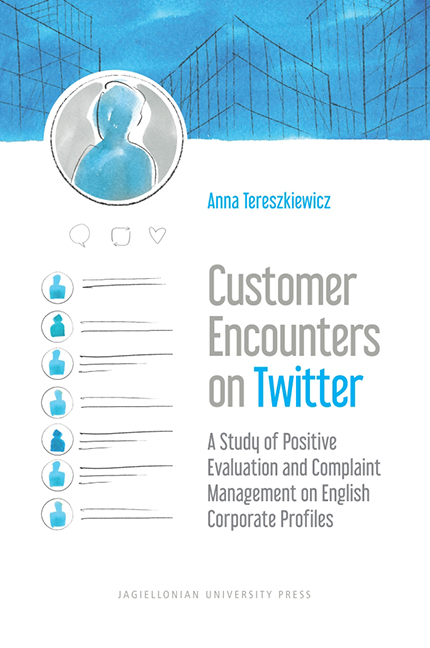 Customer Encounters on Twitter
Customer Encounters on Twitter Book contents
- Frontmatter
- Table of Contents
- Acknowledgements
- Introduction
- Chapter 1 Social media and corporate communication
- Chapter 2 Customer encounters as a genre of social interaction
- Chapter 3 Corporate profiles on Twitter – general characteristics
- Chapter 4 Positive evaluation and complaint management on Twitter
- Chapter 5 Selected politeness and lexicogrammatical properties of the tweets
- Conclusions
- References
Chapter 5 - Selected politeness and lexicogrammatical properties of the tweets
Published online by Cambridge University Press: 09 February 2022
- Frontmatter
- Table of Contents
- Acknowledgements
- Introduction
- Chapter 1 Social media and corporate communication
- Chapter 2 Customer encounters as a genre of social interaction
- Chapter 3 Corporate profiles on Twitter – general characteristics
- Chapter 4 Positive evaluation and complaint management on Twitter
- Chapter 5 Selected politeness and lexicogrammatical properties of the tweets
- Conclusions
- References
Summary
Methods
The following chapter is devoted to the analysis of selected politeness acts and lexicogrammatical properties of the messages posted by the consumers and the companies. The investigation concerns forms of address and self-identification used in the interaction, as well as the opening and closing units in the tweets. The analysis also includes the presence of lexicogrammatical properties, such as informal and non-standard language items, language mistakes and the use of such components as emoticons, hashtags and links. The main focus is placed on the presence of these components in companies’ tweets. The occurrence of the features in consumers’ messages has been provided for additional illustration.
In the course of the analysis, the presence of greetings, self-identification and thanks in the tweets was identified, as well as the forms of address used in the messages. The analysis was performed with reference to the previous research on the structure of customer encounters, on openings and closings in customer encounters in particular (Aston (ed.) 1988, Schegloff 1968, 2007, Cameron 2000b, Kerbrat-Orecchioni 2005, Marquez Reiter 2008, 2009, Biber and Conrad 2009, Friginal 2009, Félix-Brasdefer 2015). In addition, the number of tweets with informal syntactic and lexical items, non-standard language and language mistakes was counted. Tweets were examined for the presence of grammatical devices typical of the casual style of communication (cf. Joos 1959) and for the use of lexical items and spelling practices identified in previous studies as characteristic of online interaction, i.e. the presence of informal expressions, slang, elliptical structures, as well as non-standard language and language mistakes (ibid., Crystal 2006, Baron 2008, Page 2012, Zappavigna 2012, Dąbrowska 2013, Tagg 2015). The use of emoticons, hashtags and links was investigated as well.
The material for the analysis below encompasses consumers’ and companies’ tweets posted in the context of positive evaluation and complaint management. The material comprises the corpus introduced in the previous chapter, i.e. the total number of 2014 messages, with 1020 companies’ messages and 994 consumers’ tweets.
The examination of the above-mentioned properties was designed to verify the initial hypothesis concerning the reduction of conventional politeness and the use of the casual style in companies’ tweets.
- Type
- Chapter
- Information
- Customer Encounters on TwitterA Study of Positive Evaluation and Complaint Management on English Corporate Profiles, pp. 181 - 210Publisher: Jagiellonian University PressPrint publication year: 2022


